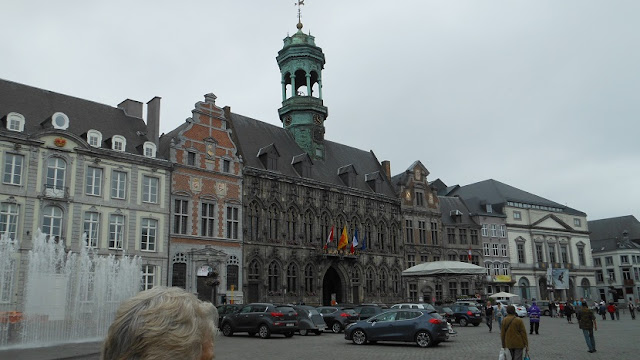During
our stay in Mons, Peter had further health issues and we returned quickly to
Nancy with Matilda being returned by a friendly ex bargee we had previously
met. Helen came with us and we showed her some of Nancy’s highlights. We stayed
at a new apartment-hotel in this architecturally dramatic building. It is
rapidly becoming known as the Cheese Grater, a nickname given it by our son
Rohan.
Quite
a dramatic shape but the likeness is obvious.
Our
return to Nancy was in the height of summer and it was interesting as we had
never seen Nancy at this time before. We found this bee in the Parc de la Pepiniere not far from where
we moor.
We
visited the Musee des Beaux Arts and
among the collections we were impressed
by the display of wonderful artisan glass. There were pieces by Emile Galle,
Rene Lalique, and the Daum brothers, amongst others.
Attractive
glass is still produced by the Daum works here in Nancy. Their styles have changed
over the years. These in heavy clear crystal started a trend in the ‘60s.
Helen
was with us until late July and of course, a visit to the popular Marche aux Puces (Flea market) in the
old town was essential.
A
month after Helen left, Peter M and his friend John joined us. John, from
London, was only with us for a few days but we managed a short cruise to
Liverdun. Liverdun is a small village on the crest of a hill overlooking a loop
in the Moselle River. We rode our bikes and climbed to the top of the town to
take in the views.
Back
to Nancy and one evening we visited Place Stanislas and watched the Son et Luminere show called Rendez-vous that was projected on the buildings around the square.
We
headed out again with Peter on to the Moselle, this time downstream and visited
Pont- a- Mousson – an industrial town that is known throughout France for the
production of cast steel manhole covers and the like. Every French street will
have metal box covers with the familiar PAM logo. It appears to be quite an
affluent town.
This
grand chapel was the centre for a wedding and outdoor reception, attended by a
large number of guests.
We
saw this 30’s Peugeot 601 in town, probably part of the entourage.
This
Deco memorial to the 1st war is pockmarked with bullet holes from
the second.
We
continued on to Metz and visited the Saint Etienne Cathedral, famous for its stained
glass windows by the famous artists Villon, Bissiere and Chagall. We wandered
the streets, admiring the many small waterways crisscrossing the town.
These
waterways were important for commercial access in the days gone by but now they
add to the city’s claim to be a Garden City.
The
Metz railway station was built between 1905 and 1908 and is now registered as an Historic Monument. It was
built on the instructions of Kaiser Wilhelm II at a time when the Germans
occupied this part of France. Designed for military use it also had “royal
apartments” for the Kaiser’s use and is known as the Station Palace. The heavy
architectural style was deliberate as he wanted to “germanify” the area.
The
building is interesting as it was built on swampy ground and was the first
building in Europe to be built on reinforced concrete piles – some 3000 of them
up to 17 metres long. A system just invented by a French engineer of the time.
As
Matilda was too big to fit comfortably in the Metz Port de Plaisance we moored against an old commercial quay and
ships like these were passing us all the time. Of the two above the loaded one
(closest to Matilda) has just passed under a low bridge. The empty one on the
far side is just about to go under it and has lowered his coach house so he
will fit – and he just did!
We
were soon back in Nancy and Peter M returned to Australia. Before he left we revisited
the Rendez-vous Son et Lumiere in Place Stanislas and he
produced a brilliant rendition which he has posted on youtube. You will find it
at: https://www.youtube.com/watch?v=-csaqt9F6EY
We
will soon have more visitors arriving and other things to do so we will keep in
touch.






















































